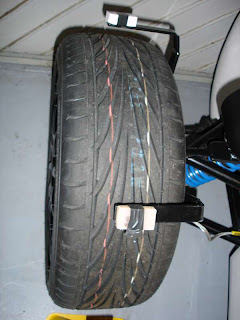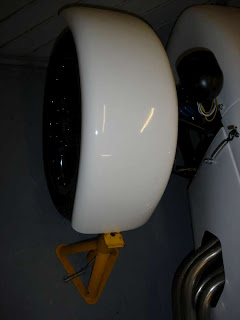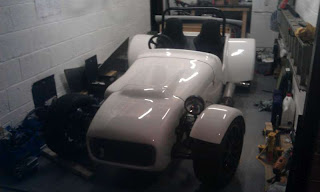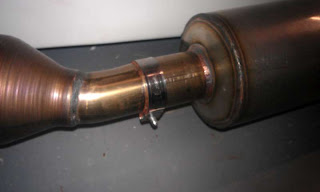The IVA test requires that the front indicators are no more than 400mm from the outside edges of the car. On the Avon this would be measured in from the rear wheel arches (being the widest part of the car). The rear arches are 1750mm in width so the indicators need to be no less than 950mm (1750 - 800) between their outside edges. As with most sevens the indicators needed extending on stalks.
I found a plastic waste overflow pipe at B&Q which is the perfect fit to hold the motorcycle indicator units.
To create a fixing to the nose cone of the car I used a 22mm copper pipe blanking cap with a M8 bolt. An 8mm bolt was used as this is the same as the indicator unit bolt. The centre of the bolt was drilled out to allow the wires to pass through. A length of rubber sleeve was used inside the bolt to prevent chafing on the edge of the hole.
As well as using glue a couple of 3.2mm rivets were used to lock the bolt in place and prevent it spinning when tightening the nut. Finally, prior to fitting, a quick coat of black paint was used to cover the copper and rivets.
To allow more clearance on the cycle wings I've changed from the 5 3/4" light units to the smaller 4" Dominator motorcycle units. Being smaller they should reduce drag (a little) and boost the top speed (a little).
The wires needed extending and protective sleeving added. The colour scheme for the wires was very bizarre. I had to trace each one to the bulb holders to work out what was going on. After the bullet connectors were attached I labelled each one to prevent future confusion.
Being a motorcycle light the Dominator has a flat beam pattern, with no kick-up to the left. This is fine for the IVA test, but to help it pass the MoT the light unit is best rotated a few degrees to give the required kick-up. To do this a second locating cut-out was filed, to the right of the original one. This causes the whole light unit to be rotated anti-clockwise when viewed from the front of the car.
Front indicators and headlights mounted and wire in. I'll replace the bullet connectors with soldered connections after the IVA test. I've ordered some proper two pin connectors from Ebay for the front indicators. This will make it easier to detach prior to removing the nose cone.
I had some black card handy in the garage so I thought I'd use it to check the beam patterns. Here is the dipped beam. Hot spot in the centre and kick-up to the left. Hopefully good enough to please Mr (or Mrs) MoT tester.
And here is the full beam.
These are small light units and are mounted quite low. As such their beam will be masked partly by the front cycle wings. This should not be too much of an inconvenience as they will really only be used to get home around dusk. I don't plan to be making too many long distance trips at night.



















































